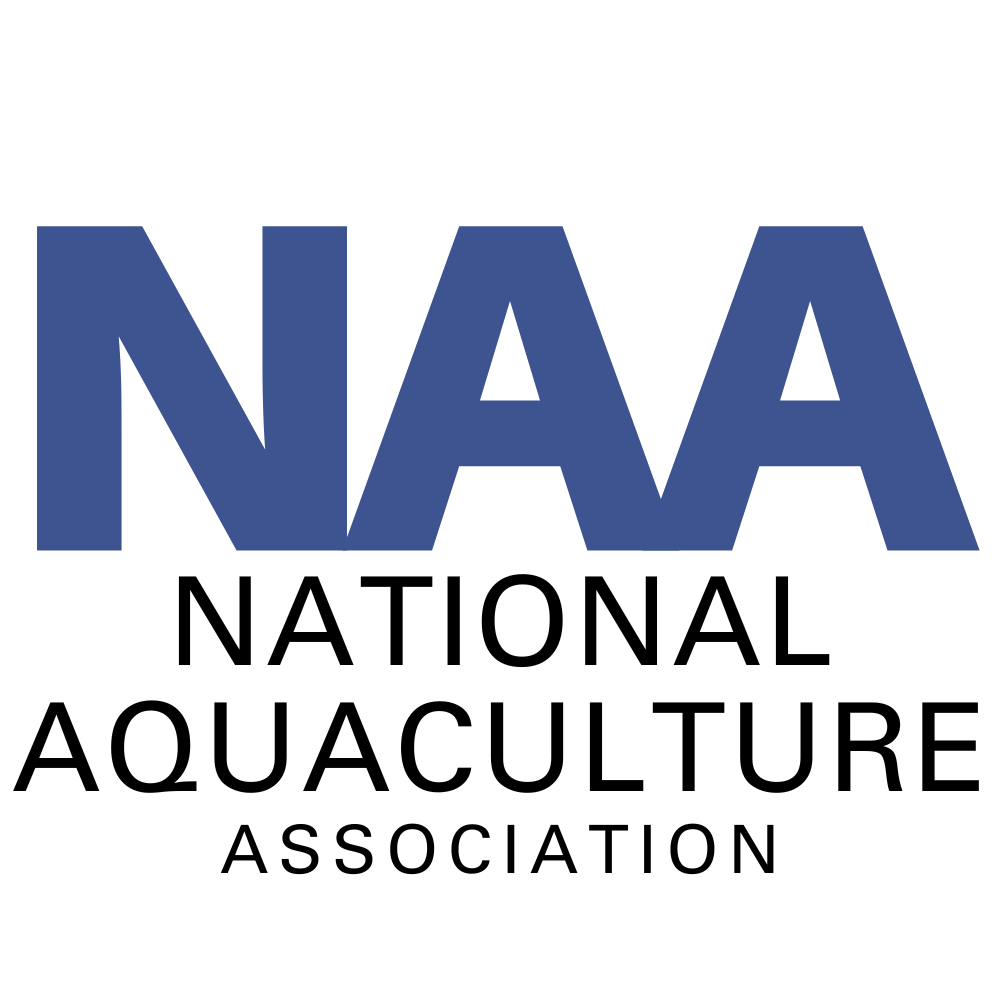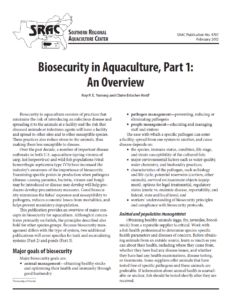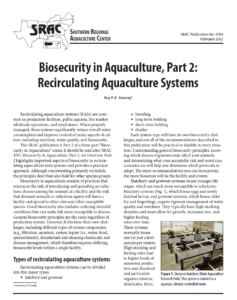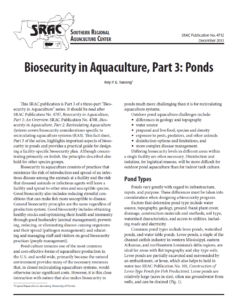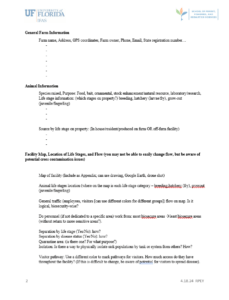Biosecurity is a critical component of any aquaculture farm.
What is biosecurity?
Biosecurity minimizes the risk of introduction and spread of infectious diseases or disease-causing agents (pathogens) to, within and from your farm. Aquatic pathogens come in many forms including bacteria, viruses, parasites and fungi. Good biosecurity reduces stress on animals which results in a strong immune system to protect against infection and prevents the introduction of harmful pathogens into and among your production systems.
Biosecurity consists of three main goals:
- Animal Management - Maintaining good husbandry practices that minimize stress and optimize the health of your animals.
- Pathogen Management - Ensuring incoming stocks are not harboring pathogens and that practices are in place to reduce or eliminate pathogen transmission to different systems on your farm or from your farm to another location.
- People Management - Protecting your animals from unintentional introduction of pathogens from employees or visitors and ensuring employees understand and are implementing best practices.
Review the USDA Sourthern Regional Aquaculture Center's Biosecurity in Aquaculture fact sheet as a first step.
Is it really worth it?
Yes! Biosecurity planning and protocols save farms time and money, ensure high aquatic-animal welfare standards, and prevents the unintended spread of pathogens to or from your farm. Similar to an insurance policy, biosecurity practices require investment and the benefits may not be immediately apparent. However, there are many reasons that farmers should make this investment, plan and execute protocols and ensure employee buy-in.
Benefits include:
- Healthier livestock and animal welfare.
- Reduces costs to manage disease, treat animals or acquire veterinary services.
- Increased animal survival and growth performance.
- Increased production and income potential.
- Improved public, industry and customer trust in your products.
- Protection against criticism from animal right organizations.
Make the investment to establish biosecurity on your farm! While it takes time to establish a plan and protocols, it is much easier to manage once in place and you'll reap the benefits.
The following resources will provide a good start to developing an overall biosecurity plan for your farm. Create a biosecurity plan, maintain good farm records, and implement proper quarantine procedures.
For any of the following topics, contact your aquaculture extension specialist, aquatic animal veterinarian or health professional, or the NAA for additional guidance.
Dr. Roy Yanong, an Extension Veterinarian with the University of Florida IFAS Tropical Aquaculture Laboratory, provides an excellent primer on aquaculture biosecurity principles and practices.
Take the time to watch this webinar.
Implementing a Biosecurity Plan
A key component of successful farm biosecurity is developing a Health and Biosecurity Plan for your specific farm, species and goals. The exercise of developing this plan will greatly improve your understanding of actual risks and ability to respond during a crisis. Be proactive so you are ready to respond! Download the biosecurity plan template to help get started.
- Develop a Health Team
- Know who to contact and when.
- Key personnel include: farm managers, extension agents, consultants, veterinarians, diagnostic laboratories, and state and federal animal health officials.
- Characterize Risks
- Identify and maintain key records.
- Identify critical control points on your farm.
- Establish Management Protocols
- Create standard operating procedures to address weaknesses.
- Educate staff on the importance of biosecurity and specific procedures.
- Generate staff buy-in and establish oversight and accountability.
- Keep the Plan Updated
- Review and update the plan regularly as goals and practices may change on your farm.
- Ensure ongoing education of staff, especially new employees.
- Communicate with your health team and stay up-to-date on current issues and trends.
Biosecurity Record Keeping
Good recordkeeping is essential for all businesses, including aquaculture production facilities.
Without records, farmers lack the information necessary to make optimal decisions and do not benefit from the experience gained during rearing previous cohorts. Good data on production parameters (growth rate, mortality rate, feeding rates) allow for the optimization of production practices. Often, it is only in hindsight that the value of a specific piece of information is needed when a farmer realizes it should have been recorded all along. It is easy to assume that some information, which appeared important at the time, will be remembered; but time and potential employee turnover will make it very difficult to obtain the information with certainty. Once put in practice, recordkeeping takes very little time and will prove very useful.
Some specifics may not be relevant for all aquaculture species and systems, but the general concepts are relevant. Contact your aquaculture extension specialist, aquatic animal veterinarian or health professional, or the NAA for additional guidance.
Implementing Quarantine Procedures
The introduction of new animals to an existing facility/system/site is one of the most common points of entry for pathogens (organisms that can cause disease, e.g., parasites, bacteria, viruses, and fungi/water molds) in aquaculture. Even though new animals may appear healthy or may have been recently tested for a specific disease pathogen, there is always a serious risk of introducing carriers (animals that carry a pathogen but do not show signs of disease). It is always a good practice to conduct diagnotic testing, if possible, on new animals prior to entry.
Quarantine is one of the most powerful biosecurity tools for aquaculture producers to protect their existing healthy populations. It consists of a strict isolation period for new animals prior to adding them to the existing stock or into shared water systems and allows for detection and elimination of some carriers or diseased animals without putting the existing stock at risk. The quarantine period also allows new animals to acclimate to their new rearing condition (water source, feed, etc.) and recuperate from the stress of transportation, without coming into contact with the resident population that may also contain carriers.
The number of days recommended for quarantine can vary from a generally accepted range of 3-4 weeks. Factors that may decrease or increase this duration include a) history of, and/or testing for specific disease pathogens from the source population and/or b) concerns for specific pathogens which may have significant adverse economic effects if established and/or may be of national or international concern.
Your farm's quarantine protocols should include the following principles:
Special thanks to Dr. Roy Yanong, an Extension Veterinarian with the University of Florida IFAS Tropical Aquaculture Laboratory, for providing the resources on this page.
Please consider this website and any template as living documents that may be updated periodically as needed. Dr. Yanong welcomes any questions or feedback on these resources and templates. Contact him anytime rpy@ufl.edu!
Please keep in mind this information is provided for informational purposes only.
Seek individualized, professional legal advice prior to implementing these practices to ensure compliance with legal standards and contact local law enforcement if you anticipate protests. Learn your rights and protections under local, state or federal law.
Do not hesitate to contact the NAA with
questions or comments at (251) 504-6995 or
naa@nationalaquaculure.org
